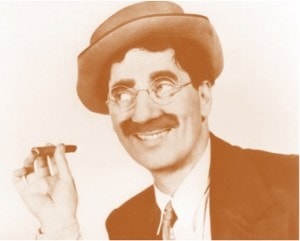AAOS PRP Studies: Huh?
The evolution of a new medical technique follows a predictable sequence of events. First, a few brave pioneers try something new and see dramatic results, then business gets involved to create hype, the hype peaks just as the new technique gains wide popularity and everyone believes the new technique is better than sliced bread. The final act of the play is a bit like a Groucho Marx saying, “I would not join any club that would have me as a member…” Meaning, by the time the technique reaches wide acceptance, the careful controls used by the original brave few to get great results have disappeared and studies invariably show that the technique used differently in the hands of others doesn’t work that well. Such is the predictable rise and fall of PRP at the AAOS meeting this week. Three surgical studies not using PRP (Platelet Rich Plasma), but PRFM (a PRP cousin that traps platelets in a dense clot), showed that surgeries with a PRFM clot implant were no better than shoulder surgeries without the clot. The first thing that comes to mind is, wasn’t PRP supposed to prevent the need for shoulder surgeries since most shoulder surgeries have not been shown to be more effective than no surgery? The fourth study is equally confusing as a surgeon performed PRP injections into 5 NFL players with acute hamstrings injuries and 5 other players underwent traditional rehabilitation. First, it’s amazing this study made it to the podium, as any study with 5 subjects in each group is only an early pilot study and there was nothing else compelling (like changes in imaging) to make the study interesting. The author concluded that since there wasn’t a difference in time till return to play between the two groups, the PRP didn’t work. The biggest issue with this study is that these were fresh injuries (17-20 days old). In our clinical experience, PRP works best to help something heal that’s having difficulty healing on it’s own. A highly active athlete with a week old hamstring injury is not in this category, in fact his hamstring is still healing on it’s own. So why would we expect PRP to hasten the recovery of an injury that’s expected to heal on it’s own? In addition, while the number of subjects are really too small to analyze, the longest it took to heal a player in the PRP group was 30 days compared to 81 days in the rehab group. Also the range of healing times in the rehab group (8-81 days) shows that there were at least two types of hamstring tears present in these players-the very mild type that would get better quickly on it’s own and the very severe type (perhaps spinal nerve root problems that went undetected? see our practice’s Orthopedics 2.0 book). As a result, there’s no way to tell if the PRP or rehab groups had more or less of these severe hamstring injuries, which would skew the small dataset severely. Finally, while the press releases don’t say, I have to assume that these were blind injections of PRP, so there’s no way to tell if the injections were actually in the hamstrings tendon (see our posts on accurately placing cells versus blind injections).
So what’s the real problem? One of the surgeon authors quoted made a really smart observation in saying that no study at AAOS had characterized these cells to know what was actually being injected. As I have blogged before, producing PRP in a bedside centrifuge is easy, but you have no idea what you’re getting out. Is the PRP concentrated enough? Too concentrated? Does the patient have enough of the right kind of growth factors in his or her cells to get the job done? As my Groucho Marx sequence of medical procedure adoption predicted, putting new tools in the hands of the masses who eventually use them differently and then study these new uses, is an important part of the adoption of new health care technologies. However, it is painful to watch!

NOTE: This blog post provides general information to help the reader better understand regenerative medicine, musculoskeletal health, and related subjects. All content provided in this blog, website, or any linked materials, including text, graphics, images, patient profiles, outcomes, and information, are not intended and should not be considered or used as a substitute for medical advice, diagnosis, or treatment. Please always consult with a professional and certified healthcare provider to discuss if a treatment is right for you.

